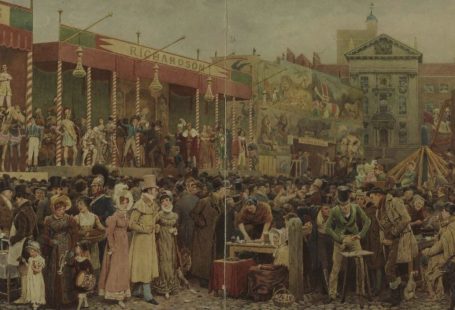Following on from reaching our wonderful milestone of 50 million newspapers pages last week, which you can read more about here, we have added an incredible 534,520 brand new newspaper pages to The Archive over the last seven days. Making up a portion of these half a million brand new newspaper pages are seventeen brand new newspaper titles from England, Wales, Scotland and Ireland, whilst we have also updated 102 of our existing titles.
So read on to find out more about all of our new newspaper titles of the week, from Bedworth to Brecknock, from Llanelli to Loughbourgh, from Sleaford to Sydenham, as well as to discover which of our existing titles we have added new pages to. Meanwhile, as part of aviation April on The Archive, you can learn about the first ever successful flight over the Irish Sea, which was completed 110 years ago this week by Irish aviator Denys Corbett Wilson.
Register now and explore the Archive
We kick off our tour of our new titles of the week in Wales, where two new titles have joined us over the past seven days. Shining a new light on The Archive is the Brecknock Beacon, which was founded as the Brecon Free Press and General Advertiser in 1882. A Conservative publication, it appeared every Saturday at the cost of just one penny, circulating in the market town of Brecon (which was archaically known as Brecknock) and throughout the historic county of Brecknockshire.

Filling eight pages, the Brecknock Beacon featured local news from the Brecon Town Council, the Brecon Quarter Sessions and the Brecon Borough Petty Sessions, as well as the latest from Llangenny and Crickhowell. It also contained special interest features, looking at ‘Gossip on Dress’ and ‘Gardening Operations for the Week,’ as well as covering national and international news, and serialised fiction.
Our second Welsh title of the week is the Llanelli Star, which was founded in the Carmarthenshire market town of Llanelli in 1909, which lies to the north west of Swansea. Still published to this day, the Llanelli Star has the reputation of being one of the ‘best read newspapers’ in the area, with a focus on ‘truly local news.’ Its devotion to local news has led to the publication forging a ‘special place in the hearts of the community,’ and the newspaper is printed in three separate editions: the main Llanelli one, and then editions for Burry Port and the Gwendraeth Valley respectively.

It’s to Scotland we go now for our third new title of the week, which is the historic Glasgow Mercantile Advertiser. Founded in 1849, this newspaper ‘circulated in Glasgow, Greenock, Leith, Dundee, Aberdeen, and other principal seaports and manufacturing towns of Scotland.’ Meanwhile, its pages contained a plethora of shipping and other information, as laid out below:
…[the newspaper] contains the Clyde shipping gazette; vessels loading, arrivals and sailing sof foreign vessels; cargos discharged and landed; Clyde vessels homeward bound; sailings and arrivals out, with the contents of cargoes coming from principal ports; vessels spoken with; sailings and arrivals at Grangemouth…
Nothing if not thorough, the Glasgow Mercantile Advertiser also contained information on money markets and current prices. Indeed, it was said that the publication was ‘more to be seen in places of business than any other Glasgow newspaper whatsoever,’ and that it was ‘constantly referred to by the trading community during the week.’

We hop across the Irish Sea for our next new title of the week (more on crossing the Irish Sea later) to welcome the Evening News (Waterford) to our collection. Appearing daily, barring Sundays and Fridays, the Evening News filled four pages and cost just one halfpenny. With an emphasis on sport, from racing to weight lifting, from cricket to football, the Evening News also featured local news, for example reporting on the latest from the Waterford Board of Guardians. Published in Waterford, the oldest and the fifth most populous city in Ireland, this newspaper was absorbed into the Waterford News & Star, which is still published to this day, and has the highest newspaper circulation in the city.

Back across the Irish Sea now to England, where we will take a look at our new English regional titles, which hail all the way from Bedworth to Uxbridge. And it’s in Bedworth that we begin, with the Bedworth Echo, which was founded in the Warwickshire market town in 1979. ‘For the people of Bedworth, Bulkington, Keresley, Exhall, Ash Green, Longford and Collycroft,’ the Bedworth Echo was a weekly freesheet that was founded by Nuneaton sports journalists Mort Birch and Alan Robinson. Appearing every Thursday, the newspaper was the only publication to exclusively serve Bedworth, and it ran until 2009.
Next up this week is the Billingham & Norton Advertiser, another weekly freesheet, which this time was published in the County Durham town of Billingham, which lies in the Borough of Stockton-on-Tees, from 1989. This newspaper appeared every Wednesday, with a circulation of just over 24,000 copies a week. The Billingham & Norton Advertiser was later merged with the Stockton, Yarm & Thornaby Advertiser to become the Stockton & Billingham Herald & Post.
Our next new title of the week comes from Cannock, Staffordshire, and is the Cannock Chase Post, which was founded in 1979. Adding a ‘splash of colour’ to the lives of local residents, with a circulation of nearly 80,000 copies in the early 1990s, this newspaper was ‘highly regarded’ for the quality of its journalism under editor Mike Lockley. Renowned for its ‘vivid prose,’ the Cannock Chase Post appeared every Thursday, alongside its sister paper the Burntwood Post. The final edition of this title appeared in 2011.

From Cannock to Cheltenham, and we’re delighted to welcome the Cheltenham News to our collection this week. Published in the historic spa town of Cheltenham, Gloucestershire, which lies in the Cotswolds, this weekly freesheet appeared every Thursday and had a circulation of nearly 50,000.
We move now to Leicestershire for our next new title of the week, which is the Hinckley Herald & Journal. Founded in the south west Leicestershire market town of Hinckley in 1985 as the Hinckley & Bosworth Trader, this newspaper served the towns of Hinckley and Boswell, as well as the villages of Barwell, Burbage and Earl Shilton. It was the town of Hinckley’s first ever weekly freesheet, and it was launched as a sister paper to the Hinckley Times. With a circulation of 35,000 copies a week in the 1980s, the final edition of the Hinckley Herald & Journal was published in 2011.
From Hinckley to Kensington, and our latest West London title to join The Archive, the Kensington News and West London Times, which was founded in 1869. Independent in its politics, this newspaper was edited in the 1870s by Dr. Maurice Davies, and circulated through ‘Kensington, Notting Hill, Bayswater, Paddington, Hammersmith, Brompton, Chelsea, Fulham, Walham Green, Chiswick, Acton, and Ealing.’ Costing just one penny, it appeared every Saturday.

After a brief sojourn in London we zip back up to Leicestershire to introduce the Loughborough Mail to our collection, which was founded in 1987 as a replacement for the Loughborough News. A weekly freesheet that appeared every Thursday, this newspaper was delivered to homes across the market town of Loughborough, the Borough of Charnwood, as well as across Sileby, Mountsorrel and Shepshed. The final edition of the Loughborough Mail was printed in 2012.
We take a trip to the West County now to welcome the Plymouth Extra to The Archive, which was established in 1979 as the Plymouth Advertiser. Relaunched in 1985 as the Plymouth Extra, this publication was known as the ‘South West’s No. 1 Free Newspaper,’ and was delivered to over 114,000 homes across Plymouth, Plympton, Saltash, Wembury, Yelverton, Horrabridge, Ivybridge and Tavistock. From 1987 the newspaper reverted to its former title, and from 1997 it was known as either The Extra or the Plymouth Extra. It ceased publication in 2011.
We’re travelling north for our next new title of the week, which is the Runcorn & Widnes Herald & Post. This newspaper, with the tag line of ‘The Best Things In Life Are Free,’ was launched in 1989 as a replacement for the Runcorn & Widnes Weekly News Extra. It circulated in the Cheshire towns of Runcorn and Widnes, as well as the villages of Frodsham, Helsby, Ditton and Palacefields, appearing every Friday before it was ultimately replaced by the Weekly News Extra in 2009.

Moving east now to Lincolnshire, and to the wonderfully named Sleaford Target, which was launched in 1984 as a weekly freesheet. Appearing every Thursday in the Lincolnshire market town of Sleaford, the Sleaford Target was distributed in Boston, Sleaford, Coningsby, Tattershall, Woodhall Spa, Horncastle, Spilsby, Skegness, Chapel St Leonards and Ingoldmells. In 2013 the Sleaford Target ceased to be free, and it is published to this day, containing local news, notices of upcoming events and property content.
We’re back to London with our final trio of new titles, and we begin by looking at the historic St Pancras Gazette, which was founded in 1866. ‘A Register for the North Western District,’ the St Pancras Gazette appeared every Saturday at the cost of one pence, and circulated in Camden Town, Kentish Town, Hampstead, Highgate, and Holloway. Indeed, the newspaper claimed that ‘No other medium has any comparable entrée with this Gazette’s into the social, political, professional, and business circles of the district.’

By 1900 the St Pancras Gazette had grown to fill eight pages, and contained local and national news, with reports on the Kentish Town Women’s Institute and on local fires and accidents. The newspaper also featured an array of special interest articles, from the ‘For Mothers and Daughters’ column authored by Madame Rose, to ‘Society Papers,’ from ‘Bits From Books’ to ‘Literary Notes.’
Our penultimate new title of the week is the Sydenham, Forest Hill and Penge Gazette, which was established in 1872 with the lengthy name of the Sydenham & Penge Gazette, Crystal Palace News and Brockley, Catford Bridge, Dulwich, Anerley, and Norwood Observer. Appearing every Saturday, this title was the ‘only newspaper published in Sydenham,’ which lies in south east London, and was historically a part of Kent.

The Sydenham, Forest Hill and Penge Gazette, moreover, claimed a ‘large and influential circulation,’ and was known as the ‘recognised local organ amongst the clergy, gentry, and inhabitants of’ Sydenham and its environs. This newspaper was neutral in its politics.
Our final new title of the week is the Uxbridge Informer, which sits alongside other West London and Surrey Informer titles, which include the Harrow Informer and the Hounslow & Chiswick Informer. Published in Ruislip, the Uxbridge Informer was delivered every Thursday to over 80,000 homes across Uxbridge, Hayes, West Drayton, Denham, Ickenham, Ruislip, Eastcote, Hillingdon, Cowley and Yeading.
That’s it from all of our new titles of the week – and with new pages joining over 100 of our existing titles this week it’s been difficult to pick out some highlights. But we have done so, and our picks include the over 5,000 pages we have added to one of our Welsh language titles Herald Cymraeg, and the over 6,000 pages that have joined our special industry title the Yorkshire Factory Times. Meanwhile, we have added over 11,000 pages to both the Harrow Observer and to the Loughborough Echo, as well as over 10,000 pages to the Buckinghamshire Examiner.
The First Flight From Britain to Ireland – 22 April 1912
110 years ago this week, pioneering Irish aviator Denys Corbett Wilson (1882-1915) made the first ever successful flight from Britain to Ireland, crossing the Irish Sea, but his achievement was not without tragedy.
On 20 April 1912, our new title the Evening News (Waterford) reported on the fears for ‘Missing Airman,’ Damer Leslie Allen, another Irish born aviator, who had also set out to fly from Britain to Ireland:
Anxiety is beginning to be felt at the absence of any tidings of the daring young Irish aviator, Mr. D. Leslie Allen (nephew of Mrs. Allen Cheekpoint) who left Chester on Thursday in his Gnome-Bleriott monoplane with the intention of flying to Dublin, and has not been heard of since he was seen flying over Holyhead.

The article continued:
An opinion is expressed that Allen may have dropped to the sea, and that he was fully equipped with floats and lifebelt, he may be able to keep afloat till picked up by a passing vessel. It is also surmised that he may have landed in some remote part of the Wicklow Mountains, or have been driven back to the Welsh hills.
Tragically, Allen and his aircraft had disappeared, never to be seen again. The aviator, who was then aged 34, was declared legally dead a couple of months later. But the accident to Allen, the cause of which was never discovered, did not deter his friend Denys Corbett Wilson, as reported the Evening News:
The other Irish aviator, Mr. Corbett Wilson, who started to fly from London to Dublin with Mr. Allen, has reached the South Welsh coast, and proposes to continue his flight, but until some tidings of his rival come to hand it is to be hoped that he will defer his attempt.

Wilson, however, did not ‘defer his attempt,’ despite Allen’s disappearance. On 22 April 1912 the Evening News reported how he had left ‘this morning for Ireland,’ a later telegram reporting how he had arrived at Enniscorthy, County Wexford. In spite of ‘bad and foggy weather…which interfered with his course,’ Denys Corbett Wilson had made the pioneering journey, which had represented ‘a formidable obstacle to aviators.’
Wilson’s achievements made him something of a celebrity, especially in his home country of Ireland, the Evening News on 12 June 1912 reporting how the young aviator had ‘won a place in the front rank of British aeroplanists by his daring and successful flight across the Channel.’ This article gave some further background to Wilson’s flight:
Mr. Wilson is a young gentleman of means, and, though not long a student of the fascinating pastime, has readily achieved wonderful success. He favours the Bleriot type of machine, and has engaged the services of an expert French mechanic to look after the delicate mechanism of the wonderful contrivance which skims through the air like a bird.

Some months later, and Wilson was again flying across the Irish Sea, ‘a large crowd’ witnessing his departure from Fishguard, as reported the Evening News on 21 September 1912. A telegram, which was later received by the newspaper, relayed how:
…Mr. Corbett Wilson, the aviator, landed this morning at Gorey, Co. Wexford, after a very successful flight from Fishguard. The weather conditions prevented him from completing his journey to Kilkenny.
Wilson again made the pages of the Evening News in October 1912, when an advertisement appeared for a demonstration of his ‘phenomenal flights,’ which had been arranged in conjunction with the Clonmel Picturesque Place Association.

Tragically, Denys Corbett Wilson would lose his life flying some three years later, but not due to any misadventure. While serving as a Lieutenant for the Royal Flying Corps during the First World War, his aircraft was hit by an enemy shell, killing him and his observer instantly. Wilson is buried at Cabaret-Rouge British Cemetery, Souchez, France.
New Titles
Title |
Year Range |
| Bedworth Echo | 1980, 1987-1988, 1992, 1995 |
| Billingham & Norton Advertiser | 1987 |
| Brecknock Beacon | 1886 |
| Cannock Chase Post | 1992 |
| Cheltenham News | 1987 |
| Evening News (Waterford) | 1900-1901, 1905, 1910 |
| Glasgow Mercantile Advertiser | 1882 |
| Hinckley Herald & Journal | 1988 |
| Kensington News and West London Times | 1876, 1882, 1887-1888, 1913, 1917-1918, 1920, 1922, 1925, 1927-1928, 1930-1934, 1938-1939, 1944, 1950, 1952-1954, 1957-1962, 1965, 1967, 1970-1971 |
| Llanelli Star | 1990 |
| Loughborough Mail | 1989 |
| Plymouth Extra | 1987 |
| Runcorn & Widnes Herald & Post | 1991 |
| Sleaford Target | 1991-1992 |
| St. Pancras Gazette | 1873-1939 |
| Sydenham, Forest Hill & Penge Gazette | 1875-1881 |
| Uxbridge Informer | 1986, 1988 |
Updated Titles
This week we have updated 102 of our existing titles.
You can learn more about each of the titles we add to every week by clicking on their names. On each paper’s title page, you can read a FREE sample issue, learn more about our current holdings, and our plans for digitisation.
You can keep up to date with all the latest additions by visiting the recently added page. You can even look ahead to see what we’re going to add tomorrow.






